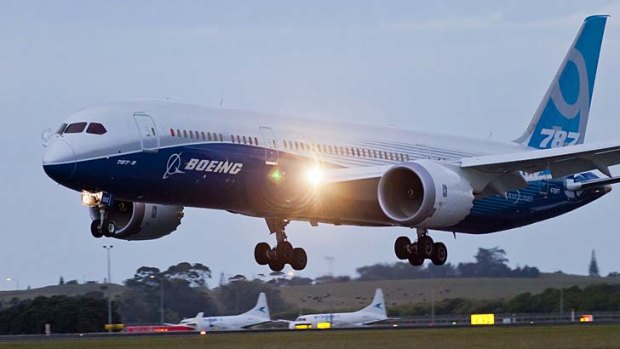This was published 10 years ago
How the long-range Dreamliner will change Australia's long-haul routes

A United Airlines Boeing 787 Dreamliner.Credit: AFP
A decade ago, with the retirement of Concorde and a yawning lack of interest from airlines for a 20 per cent faster Boeing Sonic Cruises, affordability replaced speed.
Early in the 21 century, that means cheaper tickets for paying punters rather than cheaper planes for airlines, who will pay handsomely for relief from skyrocketing jet fuel fuel prices, which have risen almost tenfold in the past two decades.
For Jetstar, which spends about 40 per cent of every dollar it takes in on jet fuel – even higher as a percentage of long-haul international costs – that is the real reason for the celebration over the arrival of the Boeing 787 Dreamliner this year.

The stretch Boeing 787-9 Dreamliner makes its international debut in New Zealand.
In one fell swoop, airlines like Jetstar, which are necessarily more penalised for the fuel bill than full-service carriers, like its parent Qantas (27 per cent at the bowser), that means an otherwise unachievable one-off saving on overall costs of as much as eight per cent, with the 787 burning up to 20 per cent less fuel per seat compared with predecessors like the 767 through using lightweight construction materials.
And, right from the time that Boeing began selling the smallest Dreamliner, the 787-3 (never built), Jetstar was almost as interested in the longer-range 787-9 version as the longer-range 787-8s it already has.
In the middle of the last decade, former Qantas boss Geoff Dixon was under intense pressure over the money he was banking from the Australian government’s decision to keep Singapore Airlines off the Sydney-Los Angeles route (combined with the financial weakness of US carriers like United Airlines, which were crippled by the 2001 terror attacks).
Though it has never been heard of since, Dixon began spruiking the idea of having the newly invented Jetstar flying on the Sydney-LA route as a sop to Australian consumers, who were paying Qantas fares of $2000-$3000 return at the time.
But the 787-9 wasn’t just an idea for low-cost airlines like Jetstar: full-service like the now merged United and Continental were thinking separately about the aircraft’s vast trans-Pacific range to fly to Australia.
Because it had no major west coast USA operation, Continental had wanted to enter the Australasian market with the first ever non-stop service between its Houston, Texas base and Auckland. But as the junior partner in the United Continental merger, the idea hasn’t been heard of since.
Meanwhile, in Chicago, UA had big plans for the Dreamliner, eventually announcing last week that its experimental and unsuccessful 747-400 non-stops between LA and Melbourne would return with six return Dreamliner flights a week, replacing the annoying Sydney stopover for UA’s Victorian customers.
In October, the UA Sydney-Melbourne tag flight will be axed as UA switches to Boeing 777s flying to the Sydney capital from LAX and San Francisco. Because the departure times of the SFO and LAX no longer have to be linked, UA says it can improve its connections in both cities for onward travellers.
The bonanza for carriers like UA is that they get an aeroplane with the same economics per seat as the 374-seat 747-400 with an aeroplane, which, on current projections, will have around 273 seats.
New so-called city-pairs which couldn’t be justified before now make sense for Air India, for example, which last year began the first Delhi-Sydney-Melbourne non-stops.
Leading airlines like Qatar Airways and British Airways are banking on the sleek new Boeing to launch new world travel routes currently unflown like Doha to Edinburgh, Scotland, or London to Austin, Texas.
Even if the fuel companies aren’t co-operating, technological breakthroughs are making air travel cheaper than it has ever been.
Which airline or aircraft would you prefer to fly to the US with? Are you excited about the new Dreamliner expanding into long-haul routes? Post your comments below.
Sign up for the Traveller Deals newsletter
Get exclusive travel deals delivered straight to your inbox. Sign up now.